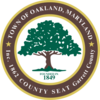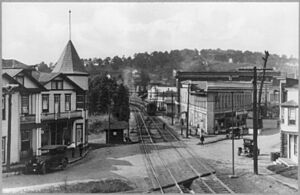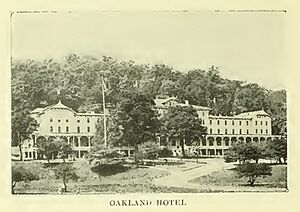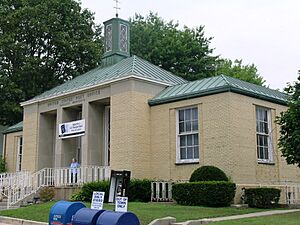Oakland, Maryland facts for kids
Quick facts for kids
Oakland, Maryland
|
|||
|---|---|---|---|
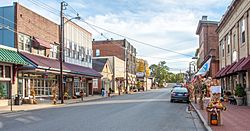
Second Street in Oakland, part of the Oakland Historic District
|
|||
|
|||
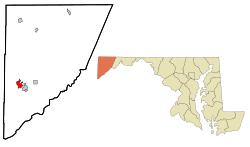
Location of Oakland, Maryland
|
|||
| Country | |||
| State | |||
| County | |||
| Incorporated | 1862 | ||
| Government | |||
| • Type | Mayor-council government | ||
| Area | |||
| • Total | 2.72 sq mi (7.05 km2) | ||
| • Land | 2.71 sq mi (7.02 km2) | ||
| • Water | 0.01 sq mi (0.02 km2) | ||
| Elevation | 2,451 ft (747 m) | ||
| Population
(2020)
|
|||
| • Total | 1,851 | ||
| • Density | 682.52/sq mi (263.53/km2) | ||
| Time zone | UTC−5 (Eastern (EST)) | ||
| • Summer (DST) | UTC−4 (EDT) | ||
| ZIP code |
21550
|
||
| Area code(s) | 301, 240 | ||
| FIPS code | 24-57650 | ||
| GNIS feature ID | 2391338 | ||
Oakland is a small town in Garrett County, Maryland, in the United States. It is the main town, also known as the county seat, for Garrett County. In 2020, about 1,851 people lived here.
Oakland is located just a few miles from where the Potomac River begins its journey to the Chesapeake Bay. It is also close to the Wisp Resort and Deep Creek Lake, which are popular places for outdoor activities.
Contents
History of Oakland
Oakland officially became a town in 1862. It has a rich history, especially with railroads.
Historic Railroad Station
The town is home to the historic B&O Oakland Station. This station was added to the National Register of Historic Places in 1973. It was later fixed up in the 2000s. Today, the station is used for special events and meetings. You can also find a gift shop inside. Even though trains still run on the tracks behind it, the station is mostly a community hub. The area in front of the station often hosts fun seasonal events, like lighting the town Christmas tree.
Main Street and Old Buildings
Oakland's Main Street features many historic buildings, some two to four stories tall. These buildings house different shops and businesses. You can find a theatre, a museum, a book store, a pharmacy, antique shops, clothing stores, and banks. Many of these buildings are built in the beautiful Victorian architecture style. A large part of downtown Oakland is recognized as the Oakland Historic District. Other important historic sites include the Garrett County Courthouse and the Hoye Site.
The Oakland Hotel
In the late 1800s and early 1900s, a large hotel called the Oakland Hotel stood near the downtown station. The B&O Railroad built it in 1878. It was a big attraction for tourists. However, it was taken down in the early 1900s.
Famous Churches
One of Oakland's most important churches is St. Matthew's Episcopal Church. Several U.S. Presidents have attended services there, including Ulysses S. Grant, James Garfield, Grover Cleveland, and Benjamin Harrison. Because of this, it is known as the "Church of Presidents." Another historic church is St. Peter the Apostle Church, a Catholic church. A large, grand neoclassical courthouse also stands proudly in the town center.
Geography and Climate
Oakland is located in the southern part of Garrett County, Maryland. It sits in a small valley. The town covers about 2.72 square miles (7.05 square kilometers) of land. Only a tiny bit of this area is water. Oakland is also very close to Deep Creek Lake, about 6.61 miles away.
Oakland's Weather
Oakland is known for being one of the coldest and snowiest places in Maryland. This is because it is located high up in the mountains and in a valley. It has a climate with warm summers and cold, snowy winters.
The coldest temperature ever recorded in Maryland was in Oakland. It was -40°F (-40°C) on January 13, 1912! In January, the average temperature is around 25.1°F (-3.8°C). In July, it's warmer, averaging about 68.4°F (20.2°C). On average, temperatures stay below freezing for about 34 afternoons each year. They drop to 0°F (-18°C) or lower about 5.8 mornings. The first freezing temperatures usually arrive around September 28, and the last are around May 15.
The hottest temperature ever recorded in Oakland was 101°F (38°C) on August 7, 1918. However, temperatures usually don't get that high. From 1981 to 2010, temperatures only reached 90°F (32°C) or higher in thirteen years.
Oakland is the snowiest place in Maryland. It gets an average of about 106.1 inches (2.69 meters) of snow each year. The most snow in one day was 40.0 inches (1.02 meters) on February 16, 1908. The first snowfall usually happens around November 13, and the last around April 7.
| Climate data for Oakland, Maryland (1991−2020 normals, extremes 1893−present) | |||||||||||||
|---|---|---|---|---|---|---|---|---|---|---|---|---|---|
| Month | Jan | Feb | Mar | Apr | May | Jun | Jul | Aug | Sep | Oct | Nov | Dec | Year |
| Record high °F (°C) | 75 (24) |
76 (24) |
83 (28) |
88 (31) |
89 (32) |
95 (35) |
98 (37) |
101 (38) |
95 (35) |
88 (31) |
78 (26) |
74 (23) |
101 (38) |
| Mean maximum °F (°C) | 61.0 (16.1) |
61.9 (16.6) |
70.5 (21.4) |
79.4 (26.3) |
83.7 (28.7) |
86.1 (30.1) |
88.3 (31.3) |
86.7 (30.4) |
84.5 (29.2) |
78.1 (25.6) |
71.2 (21.8) |
62.7 (17.1) |
88.8 (31.6) |
| Mean daily maximum °F (°C) | 36.7 (2.6) |
40.3 (4.6) |
48.9 (9.4) |
61.3 (16.3) |
70.0 (21.1) |
77.0 (25.0) |
81.0 (27.2) |
79.6 (26.4) |
73.8 (23.2) |
63.4 (17.4) |
51.5 (10.8) |
41.5 (5.3) |
60.4 (15.8) |
| Daily mean °F (°C) | 27.5 (−2.5) |
30.0 (−1.1) |
37.8 (3.2) |
49.0 (9.4) |
58.9 (14.9) |
66.5 (19.2) |
70.7 (21.5) |
69.0 (20.6) |
62.4 (16.9) |
51.4 (10.8) |
40.6 (4.8) |
32.7 (0.4) |
49.7 (9.8) |
| Mean daily minimum °F (°C) | 18.3 (−7.6) |
19.8 (−6.8) |
26.6 (−3.0) |
36.7 (2.6) |
47.7 (8.7) |
56.1 (13.4) |
60.4 (15.8) |
58.3 (14.6) |
51.0 (10.6) |
39.5 (4.2) |
29.7 (−1.3) |
23.8 (−4.6) |
39.0 (3.9) |
| Mean minimum °F (°C) | −6.5 (−21.4) |
−3.1 (−19.5) |
5.8 (−14.6) |
20.7 (−6.3) |
30.0 (−1.1) |
39.6 (4.2) |
46.4 (8.0) |
45.2 (7.3) |
35.0 (1.7) |
24.0 (−4.4) |
12.6 (−10.8) |
3.7 (−15.7) |
−9.4 (−23.0) |
| Record low °F (°C) | −40 (−40) |
−29 (−34) |
−20 (−29) |
−2 (−19) |
17 (−8) |
26 (−3) |
33 (1) |
30 (−1) |
19 (−7) |
7 (−14) |
−16 (−27) |
−32 (−36) |
−40 (−40) |
| Average precipitation inches (mm) | 3.90 (99) |
3.56 (90) |
4.32 (110) |
4.33 (110) |
5.34 (136) |
4.91 (125) |
5.14 (131) |
4.33 (110) |
3.69 (94) |
3.61 (92) |
3.38 (86) |
4.29 (109) |
50.80 (1,290) |
| Average snowfall inches (cm) | 30.2 (77) |
22.0 (56) |
19.6 (50) |
3.7 (9.4) |
0.0 (0.0) |
0.0 (0.0) |
0.0 (0.0) |
0.0 (0.0) |
0.0 (0.0) |
1.6 (4.1) |
6.4 (16) |
21.4 (54) |
104.9 (266) |
| Average extreme snow depth inches (cm) | 13.2 (34) |
9.4 (24) |
5.0 (13) |
1.0 (2.5) |
0.0 (0.0) |
0.0 (0.0) |
0.0 (0.0) |
0.0 (0.0) |
0.0 (0.0) |
1.0 (2.5) |
1.9 (4.8) |
8.3 (21) |
17.8 (45) |
| Average precipitation days (≥ 0.01 in) | 17.4 | 14.1 | 14.8 | 15.1 | 16.1 | 14.7 | 13.4 | 12.3 | 11.7 | 12.7 | 12.4 | 16.0 | 170.7 |
| Average snowy days (≥ 0.1 in) | 11.3 | 8.3 | 6.4 | 1.9 | 0.0 | 0.0 | 0.0 | 0.0 | 0.0 | 0.5 | 2.9 | 7.8 | 39.1 |
| Source: NOAA | |||||||||||||
Things to See and Do
Oakland has several interesting places to visit.
Post Office Mural
The Oakland post office has a special mural from the Great Depression era. It's called Buckwheat Harvest and was painted by an American artist named Robert Franklin Gates. This mural was part of a government program during President Franklin Roosevelt's time to help artists. It likely shows the importance of buckwheat farming in Garrett County.
Museums in Oakland
You can also visit the Oakland B&O Museum to learn about the railroad's history. The Garrett County Museum of Transportation is another great place to explore how people and goods have moved around the area over time.
Getting Around Oakland
Several main roads help people travel through Oakland. U.S. Route 219 is the most important. It goes through the town as Garrett Highway, Oak Street, and Third Street. This route connects Oakland to other towns and even to Pennsylvania and West Virginia. Other state roads like Maryland Route 39 and Maryland Route 135 also serve the town.
Famous People from Oakland
- Maurice Brookhart: A chemist and professor at the University of Houston.
- Darvin Moon: Known for being the runner-up in the 2009 World Series of Poker.
Images for kids
See also
 In Spanish: Oakland (Maryland) para niños
In Spanish: Oakland (Maryland) para niños



